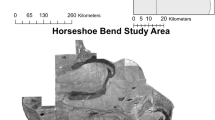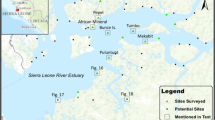Abstract
Natural color photographs were used to detect the coverage of saltcedar, Tamarix parviflora, along a 40 km portion of Cache Creek near Woodland, California. Historical aerial photographs from 2001 were retrospectively evaluated and compared with actual ground-based information to assess accuracy of the assessment process. The color aerial photos were sequentially digitized, georeferenced, classified using color and texture methods, and mosaiced into maps for field use. Eight types of ground cover (Tamarix, agricultural crops, roads, rocks, water bodies, evergreen trees, non-evergreen trees and shrubs (excluding Tamarix)) were selected from the digitized photos for separability analysis and supervised classification. Due to color similarities among the eight cover types, the average separability, based originally only on color, was very low. The separability was improved significantly through the inclusion of texture analysis. Six types of texture measures with various window sizes were evaluated. The best texture was used as an additional feature along with the color, for identifying Tamarix. A total of 29 color photographs were processed to detect Tamarix infestations using a combination of the original digital images and optimal texture features. It was found that the saltcedar covered a total of 3.96 km2 (396 hectares) within the study area. For the accuracy assessment, 95 classified samples from the resulting map were checked in the field with a global position system (GPS) unit to verify Tamarix presence. The producer's accuracy was 77.89%. In addition, 157 independently located ground sites containing saltcedar were compared with the classified maps, producing a user's accuracy of 71.33%.
Similar content being viewed by others
References
Anys, H. and He, D. C.: 1995, ‘Evaluation of textural and multipolarisation radar features for crop classification’, IEEE Trans. on Geosci. Remote Sens. 33, 1130–1181.
Bailey, Joseph K., Schweitzer, J. A. and Whitham, T. G.: 2001, ‘Salt cedar negatively affects biodiversity of aquatic macroinvertebrates’, Wetlands 21, 442–447.
Brock, J. H.: 1994, ‘Tamarix spp. (Salt Cedar), An Invasive Exotic Woody Plant in Arid and Semi-arid Riparian Habitats of Western USA’, In: L. C. de Waal, L. E. Child, C. P. M. Wade, J. H. Brock, Landscape Ecology Series; Ecology and Management of Invasive Riverside Plants, John Wiley and Sons Ltd.; John Wiley and Sons, Inc.; Chichester, UK/New York, USA, 1994, pp. 27–44.
Cleverly, J. R., Smith, S. D., Sala, A. and Devitt, D. A.:1997, ‘Invasive capacity of Tamarix ramosissima in a Mojave desert floodplain: The role of drought’, Oecologia (Berlin) 111, 12–18.
Di Tomaso, J. M.: 1998, ‘Impact, biology and ecology of saltcedar (Tamarix spp.) in the southwest United States’, Weed Tech. 12, 326–336.
Everitt, J. H. and Deloach, C. J.: 1990, ‘Remote sensing of Chinese Tamarisk (Tamarix chinensis) and associated vegetation’, Weed Sci. 38, 273–278.
Everitt J. H., Escobar, D.E. and Davis, M. R.: 1995, ‘Using remote sensing for detecting and mapping noxious plants’, Weed Abstr., 44, 639–649. CAB internal.
Everitt, J. H., Escobar, D. E, Alaniz, M. A, Davis, M. R. and Richardson, J. V.: 1996, ‘Using spatial information techniques to map Chinese tamarisk (Tamarix chinensis) infestations’, Weed Sci. 44, 194–201.
Gausman, H. W., Everitt, J. H., and Gerbermann Bowen R. L.: 1977, ‘Canopy reflectance and film image relations among three south Texas rangelands plants’, J. Range Manage. 30, 449–450.
Gong, P., Marceau, D. J. and Howarth, P. J.: 1992, ‘A comparison of spatial feature extraction algorithms for land-use classification with SPOT HRV data’, Remote Sens. Environ. 40, 137–151.
Haralick, R. M.: 1979, ‘Statistical and structural approaches to texture’, Proc. IEEE, 67, 786–804.
Haralick, R. M., Shanmugam, K. and Dinstein, I.: 1973, ‘Textural features for image classification’, IEEE Tran. Geosci. Remote Sens. 33, 1170–1181.
Hassan, A. and He, D. C.: 1995, ‘Evaluation of textural and multi-polarization radar features for crop classification’, IEEE Tran. Geosci Remote Sens. 33, 1170–1181.
Hudak, A. T. and Wessman C. A.: 1998, ‘Textural analysis of historical aerial photography to characterize woody plant encroachment in South African Savanna’, Remote Sens. Environ. 66, 317– 330.
Jonathan, C.-W. C., Defries, R. S. and Townsend, R.G.: 2001, ‘Improved Recognition of Spectrally Mixed Land Cover Classes Using Spatial Textures and Voting Classifications’, CAIP 2001, LNCS 2124, 217–227.
Lass, L. W., Carson, H. W. and Callihan, R. H.: 1996, ‘Detection of yellow starthistle (Centaurea solstitialis) and common St. Johnswort (Hypericum perforatum) with multispectral digital imagery’, Weed Tech. 11, 248–256.
Mather, P. M., Tso, B. C. K. and Koch, M.: 1998, ‘An evaluation of Landsat TM spectral data and SAR –Derived textural information for Litho logical discrimination in the Red Sea Hills, Sudan’, Int. J. Remote Sens. 19, 587–604.
Nyoungui, A. N., Tonye, E. and Akono, A.: 2002, ‘Evaluation of speckle filtering and texture analysis methods for land covers classification from SAR images’, Int. J. Remote Sens. 23, 1895–1925.
Podest, E. and Saatchi, S.: 2002, ‘Application of multiscale texture in classifying JERS-1 radar data over tropical vegetation’, Int. J. Remote Sens. 23, 1487–1506.
Riou, R. and Seyler, F.: 1997, ‘Texture analysis of tropical rain forest infrared satelliate images’, PE and RS. 63, 515–521.
Saatchi, S. S., Nelson, B., Podest, E. and Holt, J.: 2000, ‘Mapping land cover types in the Amazon Basin using 1 km JERS-1 mosaic’, Int. J. Remote Sens. 21, 1183–1200.
Shaban,M. A. and Dikshit, O.: 2001, ‘Improvement of classification in urban areas by the use of textural features: The case study of Lucknow city, Uttar Pradesh’ Int. J. Remote Sens. 22, 565–593.
Smits, P. C. and Annoni, A.: 1999, ‘Updating Land-cover maps by using texture information from very high-resolution space-borne imagery’, IEEE Trans. Geosci. Remote Sens. 37, 1244–1254.
Stohlgren, T. J., Binkley, D., Chong, G. W. Kalkhan, M. A., Schell, L. D., Bull, K. A. Otsuki, Y., Newman, G., Bashkin, M. and Son, Y.: 1999, ‘Exotic plant species invade hot spots of native plant diversity’, Ecol. Monog. 69: 25–46.
Xu, B., Gong, P., Spear R. and Seto, E.: 2003, ‘Comparison of different gray level reduction schemes for a revised texture spectrum method for land-use classification using IKONOS imagery’, PE. RS. 69, 529–536.
Zavaleta, E.: 2000, ‘The economic value of controlling an invasive shrub’, Ambio 29, 462–467.
Author information
Authors and Affiliations
Corresponding author
Rights and permissions
About this article
Cite this article
Ge, S., Carruthers, R., Gong, P. et al. Texture Analysis for Mapping Tamarix parviflora Using Aerial Photographs along the Cache Creek, California. Environ Monit Assess 114, 65–83 (2006). https://doi.org/10.1007/s10661-006-1071-z
Received:
Accepted:
Published:
Issue Date:
DOI: https://doi.org/10.1007/s10661-006-1071-z




